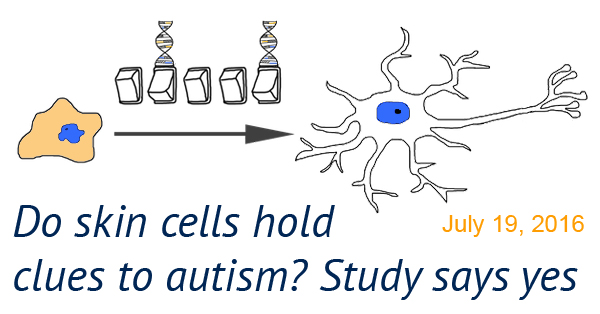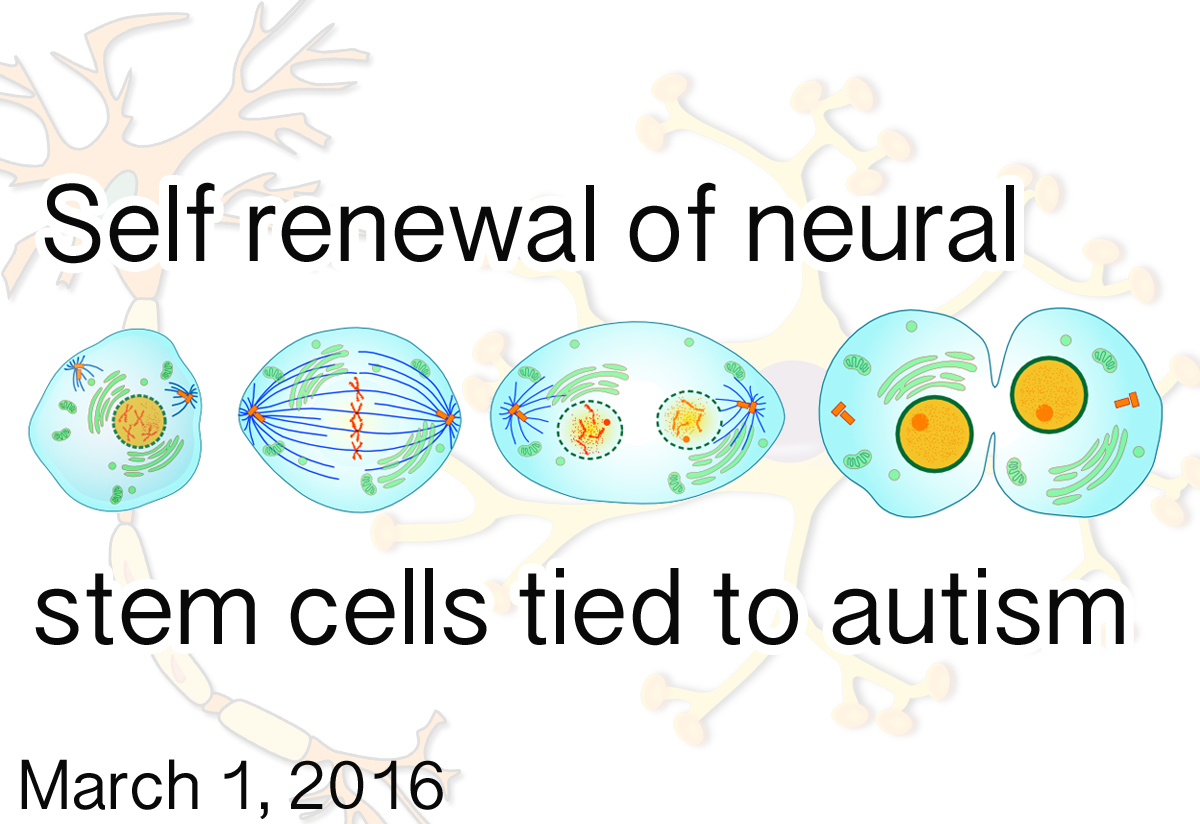Categories
Select a new category
Lab-Generated Stem Cells Hold Clues to Autism
By Chelsea E. Toledo on July 19, 2016

Background: Induced pluripotent stem cells (iPSCs) are mature adult cells that have been reprogrammed by scientists to behave like embryonic stem cells – which have the potential to become nearly any cell type in the body, including neurons. Scientists rely upon iPSCs to learn more about rare or mysterious conditions such as Autism Spectrum Disorder (ASD) by studying cells related to the condition.
What’s New: On June 29, 2016, the journal Molecular Neurobiology published a study using iPSCs to reveal clues about genetic expression, neural makeup and electrical activity in people with ASD. The researchers took skin cells from three male children who had ASD but no other neurodevelopmental conditions, as well as from their three male siblings without ASD. They then reprogrammed those skin cells to behave as embryonic stem cells and monitored their changes. In examining the neurons generated from these iPSCs, the researchers found differences in electrical activity and expression of genes related to signaling between cells in the participants with ASD compared to their typically developing siblings.
Why it’s important: This study identified 161 genes expressed differently in people with ASD, with similar features observed in the neurons of all three unrelated study participants with ASD. Future studies working with larger participant groups could further refine the cellular features differentiating cells of people with ASD during gestation, pointing to the precise process by which the disorder develops.
Help me understand :
| Source(s) : |
| Tweet |
Link Found Between Neural Stem Cell Division and Autism
By Shana R. Spindler, Ph.D. on March 2, 2016

Background: The brain grows, in part, through the activity of neural stem cells—a cell population that replenishes itself through cell division. When a stem cell divides, it has three choices. It can make two new stem cells, a stem cell and a new cell type (such as a neuron), or two new cell types.
What’s new: An error in neural stem cell division may be at the root of neurodevelopmental problems seen in some metabolic disorders, according to a new study published February 9, 2016, in Cell Reports. Researchers used mice to study if neural stem cell division requires the autism risk gene TMLHE—which is an important contributor to metabolism and energy production in the powerhouse of the cell.
They found that TMLHE is required to maintain the proper balance between neural stem cell self-renewal versus the production of different cell types. The researchers showed that providing TMLHE-deficient stem cells with carnitine, a normal product of TMLHE activity, restored the balance of neural stem cell divisions.
Why it’s important: This study provides a potential mechanism for how a known autism risk gene leads to a type of autism associated with a metabolic disorder. Most importantly, the findings suggest an avenue for treating the disorder during embryonic development with carnitine, a common nutritional supplement. While it may be tempting to get excited, this is a far off goal, as many—many—additional studies are needed before attempting to study this in humans.
Help me understand :
| Source(s) : |
| Tweet |
FDA-Approved Cord Blood Trial Underway
By Shana R. Spindler, Ph.D. on September 10, 2012
Background:
Researchers have linked Autism Spectrum Disorder (ASD) to variations in hundreds of genes, but some children with autism do not carry any of these known genetic changes. A team of doctors from the Sutter Neuroscience Institute in Sacramento, California observed that cord blood infusions helped improve the condition of a young boy who developed Cerebral Palsy after being trapped in the birth canal for seven hours. The doctors hypothesized that cord blood stem cells, which can communicate with other cells in ways we do not fully understand, may help fix the underlying problem in children with ASD.
What’s New:
The United States Food and Drug Administration (FDA) has approved a clinical trial that will examine the use of cord blood stem cells in the treatment of ASD. Thirty children who have a form of autism with no known genetic cause will receive infusions of their own cord blood in a controlled pilot study. How the cord blood stem cells will target the underlying causes of autism remains unclear.
Why it’s important:
The environmental roots of autism are poorly understood, making treatment tricky. Through innovative clinical trials, we stand to gain important information about therapeutic strategies for autism with diverse etiology.
Help me understand :
| Source(s) : |
| Tweet |
Timothy Syndrome Neuron Defects Revealed
By Shana R. Spindler, Ph.D. on December 21, 2011
Overview: Researchers have identified a set of neuronal defects that may be associated with autism using induced pluripotent stem cells made from the skin of Timothy syndrome patients, as reported in the 27 November online edition of Nature Medicine.
Background: Timothy syndrome is a genetic disorder that affects many parts of the body, including the nervous system, and is commonly associated with characteristics of autism spectrum disorders.
What's new: The researchers found that neurons from Timothy syndrome patients had both structural and chemical changes as compared to control neurons.
Why it's important: While these results still need to be examined in an animal model, the study supports the idea that induced pluripotent stem cell technology can help individualize the diagnosis and treatment of autism spectrum disorders by categorizing patients according to variations in cellular function at the level of the individual neuron.
Help me understand :
| Source(s) : |
| Tweet |

